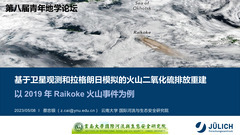报告详情
Improved estimation of volcanic SO2 injections from satellite observations and Lagrangian transport simulations: the 2019 Raikoke eruption
编号:2311
访问权限:私有
更新:2023-04-25 17:35:23
浏览:881次
特邀报告

报告开始:2023年05月08日 09:50(Asia/Shanghai)
报告时间:15min
所在会场:[13C] 13C、大气物理与气象气候 [13C-1] 13C-1 平流层-对流层大气耦合和物质交换及冰冻圈与大气相互作用
摘要
Monitoring and modeling of volcanic plumes are important for understanding the impact of volcanic activity on climate and for practical concerns, such as aviation safety or public health. Here, we apply the Lagrangian transport model Massive-Parallel Trajectory Calculations (MPTRAC) to estimate the SO2 injections into the upper troposphere and lower stratosphere by the eruption of the Raikoke volcano (48.29∘ N, 153.25∘ E) in June 2019 and its subsequent long-range transport and dispersion. First, we used SO2 retrievals from the AIRS (Atmospheric Infrared Sounder) and TROPOMI (TROPOspheric Monitoring Instrument) satellite instruments together with a backward trajectory approach to estimate the altitude-resolved SO2 injection time series. Second, we applied a scaling factor to the initial estimate of the SO2 mass and added an exponential decay to simulate the time evolution of the total SO2 mass. By comparing the estimated SO2 mass and the mass from TROPOMI retrievals, we show that the volcano injected 2.1 ± 0.2 Tg SO2, and the e-folding lifetime of the SO2 was about 13 to 17 d. The reconstructed SO2 injection time series are consistent between using the AIRS nighttime and the TROPOMI daytime products. Further, we compared forward transport simulations that were initialized by AIRS and TROPOMI SO2 products with a constant SO2 injection rate. The results show that the modeled SO2 change, driven by chemical reactions, captures the SO2 mass variations from TROPOMI retrievals. In addition, the forward simulations reproduce the SO2 distributions in the first ∼10 d after the eruption. However, diffusion in the forward simulations is too strong to capture the internal structure of the SO2 clouds, which is further quantified in the simulation of the compact SO2 cloud from late July to early August. Our study demonstrates the potential of using combined nadir satellite retrievals and Lagrangian transport simulations to further improve SO2 time- and height-resolved injection estimates of volcanic eruptions.
Monitoring and modeling of volcanic plumes are important for understanding the impact of volcanic activity on climate and for practical concerns, such as aviation safety or public health. Here, we apply the Lagrangian transport model Massive-Parallel Trajectory Calculations (MPTRAC) to estimate the SO2 injections into the upper troposphere and lower stratosphere by the eruption of the Raikoke volcano (48.29∘ N, 153.25∘ E) in June 2019 and its subsequent long-range transport and dispersion. First, we used SO2 retrievals from the AIRS (Atmospheric Infrared Sounder) and TROPOMI (TROPOspheric Monitoring Instrument) satellite instruments together with a backward trajectory approach to estimate the altitude-resolved SO2 injection time series. Second, we applied a scaling factor to the initial estimate of the SO2 mass and added an exponential decay to simulate the time evolution of the total SO2 mass. By comparing the estimated SO2 mass and the mass from TROPOMI retrievals, we show that the volcano injected 2.1 ± 0.2 Tg SO2, and the e-folding lifetime of the SO2 was about 13 to 17 d. The reconstructed SO2 injection time series are consistent between using the AIRS nighttime and the TROPOMI daytime products. Further, we compared forward transport simulations that were initialized by AIRS and TROPOMI SO2 products with a constant SO2 injection rate. The results show that the modeled SO2 change, driven by chemical reactions, captures the SO2 mass variations from TROPOMI retrievals. In addition, the forward simulations reproduce the SO2 distributions in the first ∼10 d after the eruption. However, diffusion in the forward simulations is too strong to capture the internal structure of the SO2 clouds, which is further quantified in the simulation of the compact SO2 cloud from late July to early August. Our study demonstrates the potential of using combined nadir satellite retrievals and Lagrangian transport simulations to further improve SO2 time- and height-resolved injection estimates of volcanic eruptions.
Monitoring and modeling of volcanic plumes are important for understanding the impact of volcanic activity on climate and for practical concerns, such as aviation safety or public health. Here, we apply the Lagrangian transport model Massive-Parallel Trajectory Calculations (MPTRAC) to estimate the SO2 injections into the upper troposphere and lower stratosphere by the eruption of the Raikoke volcano (48.29∘ N, 153.25∘ E) in June 2019 and its subsequent long-range transport and dispersion. First, we used SO2 retrievals from the AIRS (Atmospheric Infrared Sounder) and TROPOMI (TROPOspheric Monitoring Instrument) satellite instruments together with a backward trajectory approach to estimate the altitude-resolved SO2 injection time series. Second, we applied a scaling factor to the initial estimate of the SO2 mass and added an exponential decay to simulate the time evolution of the total SO2 mass. By comparing the estimated SO2 mass and the mass from TROPOMI retrievals, we show that the volcano injected 2.1 ± 0.2 Tg SO2, and the e-folding lifetime of the SO2 was about 13 to 17 d. The reconstructed SO2 injection time series are consistent between using the AIRS nighttime and the TROPOMI daytime products. Further, we compared forward transport simulations that were initialized by AIRS and TROPOMI SO2 products with a constant SO2 injection rate. The results show that the modeled SO2 change, driven by chemical reactions, captures the SO2 mass variations from TROPOMI retrievals. In addition, the forward simulations reproduce the SO2 distributions in the first ∼10 d after the eruption. However, diffusion in the forward simulations is too strong to capture the internal structure of the SO2 clouds, which is further quantified in the simulation of the compact SO2 cloud from late July to early August. Our study demonstrates the potential of using combined nadir satellite retrievals and Lagrangian transport simulations to further improve SO2 time- and height-resolved injection estimates of volcanic eruptions.
关键词
volcanic SO2,Lagrangian transport simulations
报告人

蔡忠银
副研究员 云南大学稿件作者
全部评论
重要日期
-
会议日期
05月05日
2023
至05月08日
2023
-
03月31日 2023
初稿截稿日期
-
05月25日 2023
注册截止日期
主办单位
青年地学论坛理事会
中国科学院青年创新促进会地学分会
中国科学院青年创新促进会地学分会
承办单位
武汉大学
中国科学院精密测量科学与技术创新研究院
中国地质大学(武汉)
中国科学院精密测量科学与技术创新研究院
中国地质大学(武汉)


发表评论